by Christian Boyles
Pack your bag, find your travel charger, get an electricity converter and buy some foreign currency, because the Summer is the perfect time to explore the world. Your UCBA library has you covered Continue reading

by Christian Boyles
Pack your bag, find your travel charger, get an electricity converter and buy some foreign currency, because the Summer is the perfect time to explore the world. Your UCBA library has you covered Continue reading
In Europe, practically every day is a communal holiday of some kind. Various saints are celebrated among Roman Catholics and Greek Orthodox, one of countless remnants of pagan gods and goddesses, the original protectors and healers, and whose birthdays were celebrated with processions, song and dance, athletic competitions, the eating of special foods and fasting, libation offerings and purifications, and sometimes with a sacrifice of plants or animals.
On Sunday, therefore, we will take the opportunity to celebrate the “birthday” of Artemis (St. Artemisius and St. Artemidos) and on Monday, it’s Apollo’s turn (7. Thargelion). The Athenian Thargelia festival dedicated to both Artemis and Apollo is most famous for picking two scapegoats (φάρμακοι) that were driven out of town to rid it of sins and plagues. In Ionia, including at Ephesus, one of the months was named after Artemis, Artemision (corresponding more or less to April [with lunar and lunar-solar calendars versus solar it’s a bit complicated]) and in Macedonia, Artemisius (corresponding more or less to May).
May 6 (6. Thargelion) is the Athenian birthday of the greatest of the Greek goddesses – Artemis (as Artemis Ephesia worshiped by “Asia and the whole world” ([Acts 19:27]). In the 2nd century an entire month named after the goddess, Artemision, was a non-working holiday at Ephesus (IvE I 24). After a hectic year, the library staff would, I’m sure, happily embrace an off-work month-long period of celebration (or rest;-)!
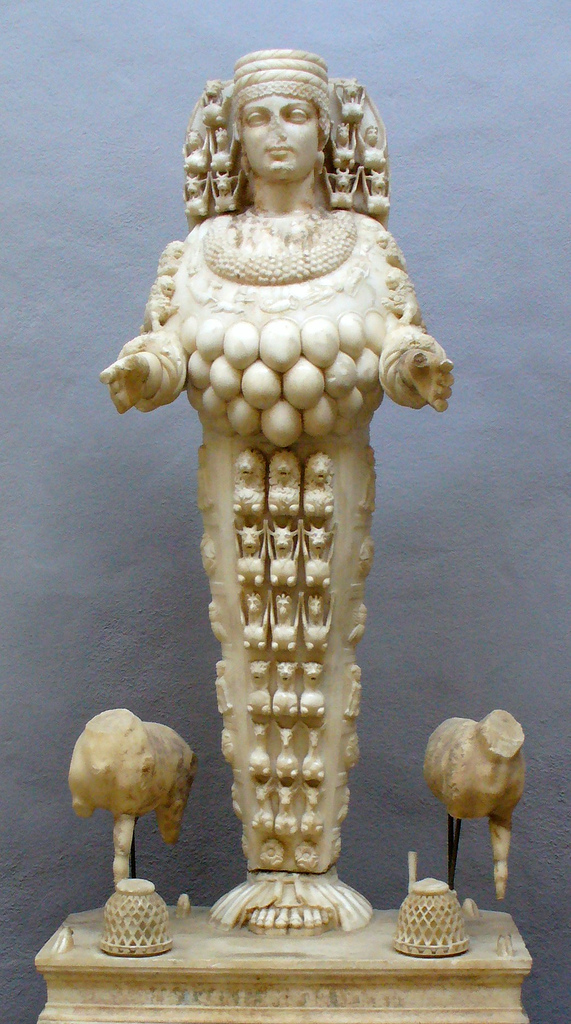
Artemis’s temples were the most numerous, especially on the Peloponnese, and the number of her epithets was surpassed only by those of Zeus. One would think that it should also be the birthday of her twin brother Apollo. However, traditions vary. In some she has no connection to Apollo and in others she even acts as midwife at the birth of her own twin brother.
Artemis was the goddess of all living things, animals and plants, but really all of nature – mountains, groves, marshes. Only later did she become the goddess of hunters. The hind was her companion, not her victim. She was associated with several Near Eastern goddesses – Anath (Hazleton, 2004, p. 114), Tanit (who shares many of Artemis’ attributes, the dove, palm tree, fish, and moon crescent), Belili (goddess of trees, the moon, wells, springs, and the willow – all sacred to Artemis), Astarte (Ishtar) (LIMC 2: 1, p. 618), Isis (LIMC 2: 2 912-913), Tyche (LIMC 2: 2 (Artemis) 893-899), Bendis (Hdt. 4.33; 5.7), Cybele (LIMC 2: 1 p. 618), the Minoan-Mycenaean goddess (Nilsson, 1971 [1950], p. 503), all stewards of nature; she is clearly mentioned in a Linear B tablet from Pylos — a-ti-mi-te (Bennett, 1955, p. 209, classification Un 219.5).
οἴκτῳ γὰρ ἐπίφθονος Ἄρτεμις ἁγνὰ πτανοῖσιν κυσὶ πατρὸς αὐτότοκον πρὸ λόχου μογερὰν πτάκα θυομένοισιν, στυγεῖ δὲ δεῖπνον αἰετῶν… τόσον περ εὔφρων ἁ καλὰ δρόσοις ἀέπτοις μαλερῶν λεόντων πάντων τ᾿ἀγρονόμων φιλομάστοις θηρῶν ὀβρικάλοισι τερπνά… (Aesch. Ag. 134-143).
For holy Artemis, out of pity, bears a grudge against the winged hounds of her Father who slaughtered the wretched hare, litter and all, before it could give birth; she loathes the eagles’ feast…So very kindly disposed is the fair one to the unfledged seed of fiery lions, and so pleasing to the suckling whelps of all beasts that roam the wild… (modified Loeb trans.).
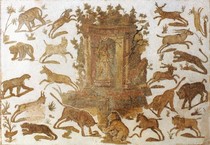
Pavement mosaic. Thysdrus, Tunisia. 2nd-3rd cent. CE.
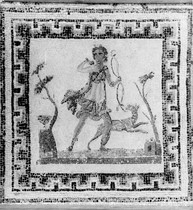
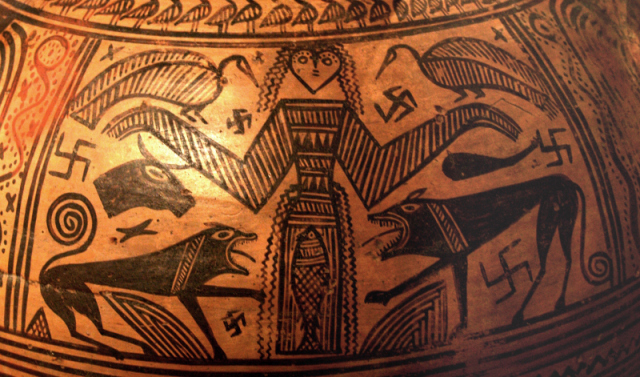
However, she was also a goddess of culture – presiding over the education of young girls and boys and of cities, too. She was the protector of youth, especially young women during rituals celebrating their menarche (at Brauron, Mounychia, Sparta, Larissa, Halai Araphenides, and many more). Song and dance took center stage in these ceremonies. Girls and young women in choruses for Artemis abound in literature.[1]
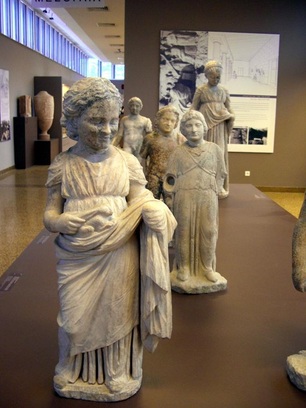
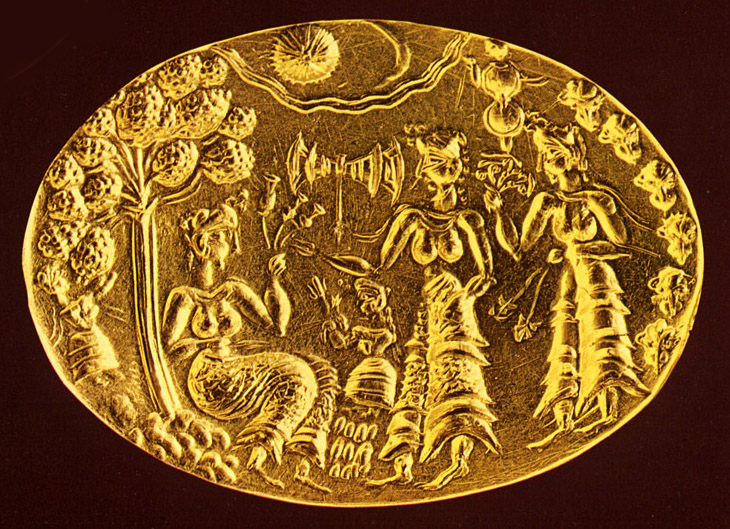

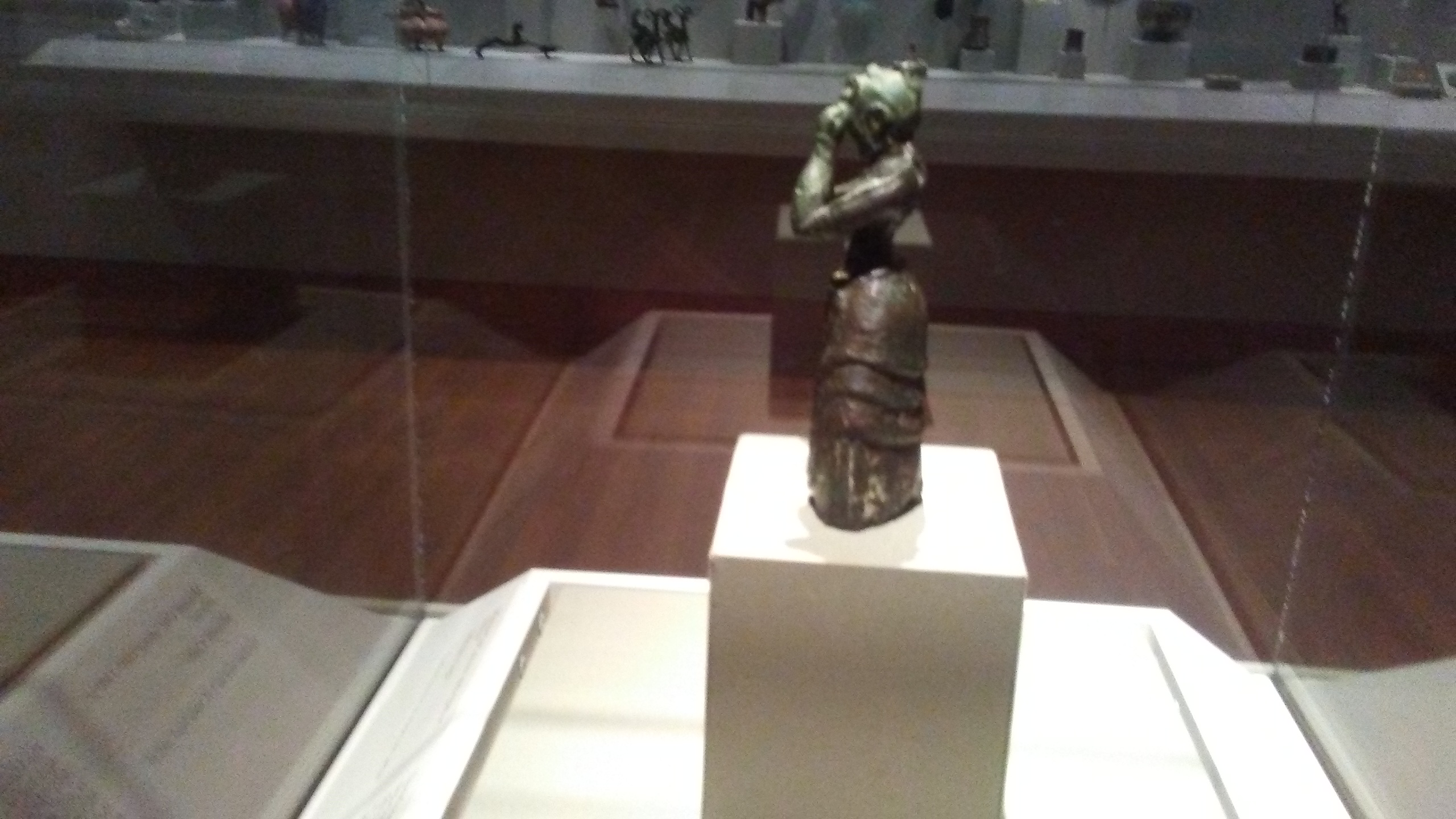
As a virgin goddess (in fact, she is one of only three goddesses (Hestia and Athena being the other two) over whom Aphrodite has no power (Homeric Hymns [to Aphrodite, 6-32]), she is the patron of unmarried women and men, children, and all first born, human and non-human alike.
ἣ δὲ μάλ᾿ οὐκ ἔθελεν, ἀλλὰ στερεῶς ἀπέειπεν,
ὤμοσε δὲ μέγαν ὅρκον, ὃ δὴ τετελεσμένος ἐστίν,
ἁψαμένη κεφαλῆς πατρὸς Διὸς αἰγιόχοιο,
παρθένος ἔσσεσθαι πάντ᾿ ἤματα δῖα θεάων.
τῆι δὲ πατὴρ Ζεὺς δῶκε καλὸν γέρας ἀντὶ γάμοιο…
(Hymn. Hom. Ven. 25-29).
She was wholly unwilling, even stubbornly refused;
and touching the head of father Zeus who holds the aegis,
she, that fair goddess, swore a great oath
that she would be a virgin always and
her father Zeus granted her a fine privilege instead of marriage…
(modified Loeb trans.).
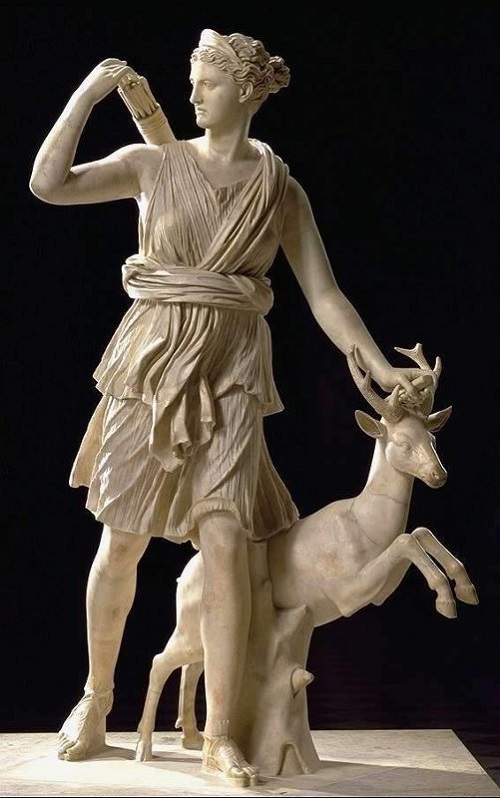
…ὡς ὅτε πατρὸς ἐφεζομένη γονάτεσσι παῖς ἔτι κουρίζουσα
τάδε προσέειπε γονῆα δός μοι παρθενίην αἰώνιον, ἄππα,
φυλάσσειν, καὶ πολυωνυμίην, ἵνα μή μοι Φοῖβος ἐρίζῃ…
…δὸς δέ μοι ἑξήκοντα χορίτιδας Ὠκεανίνας, πάσας εἰνέτεας,
πάσας ἔτι παῖδας ἀμίτρους…δὸς δέ μοι ἀμφιπόλους
Ἀμνισίδας εἴκοσι νύμφας… δὸς δέ μοι οὔρεα πάντα·
πόλιν δέ μοι ἥντινα νεῖμονἥν τινα λῇς… (Call. Hymn 3.4-7; 19-20).
…when sitting on her father’s knees, still a child, she spoke these words to her father:
“Let me keep my virginity, Father, forever: and give me many names,
so that Phoebus may not compete with me…
…And give me sixty daughters of Oceanus for my choir, all nine years old,
all virgins yet ungirdled…and give me for companions twenty nymphs of Amnisus…
And give to me all mountains; and for city, assign me any, even whichever you will…
(modified Loeb trans.).
Her mythical companions included several famous virgins (Iphigenia, Atalanta, Callisto, Hippolytus, and countless more). Euripides’s famous play tells the tale of the tragic fate of the virgin Hippolytus.
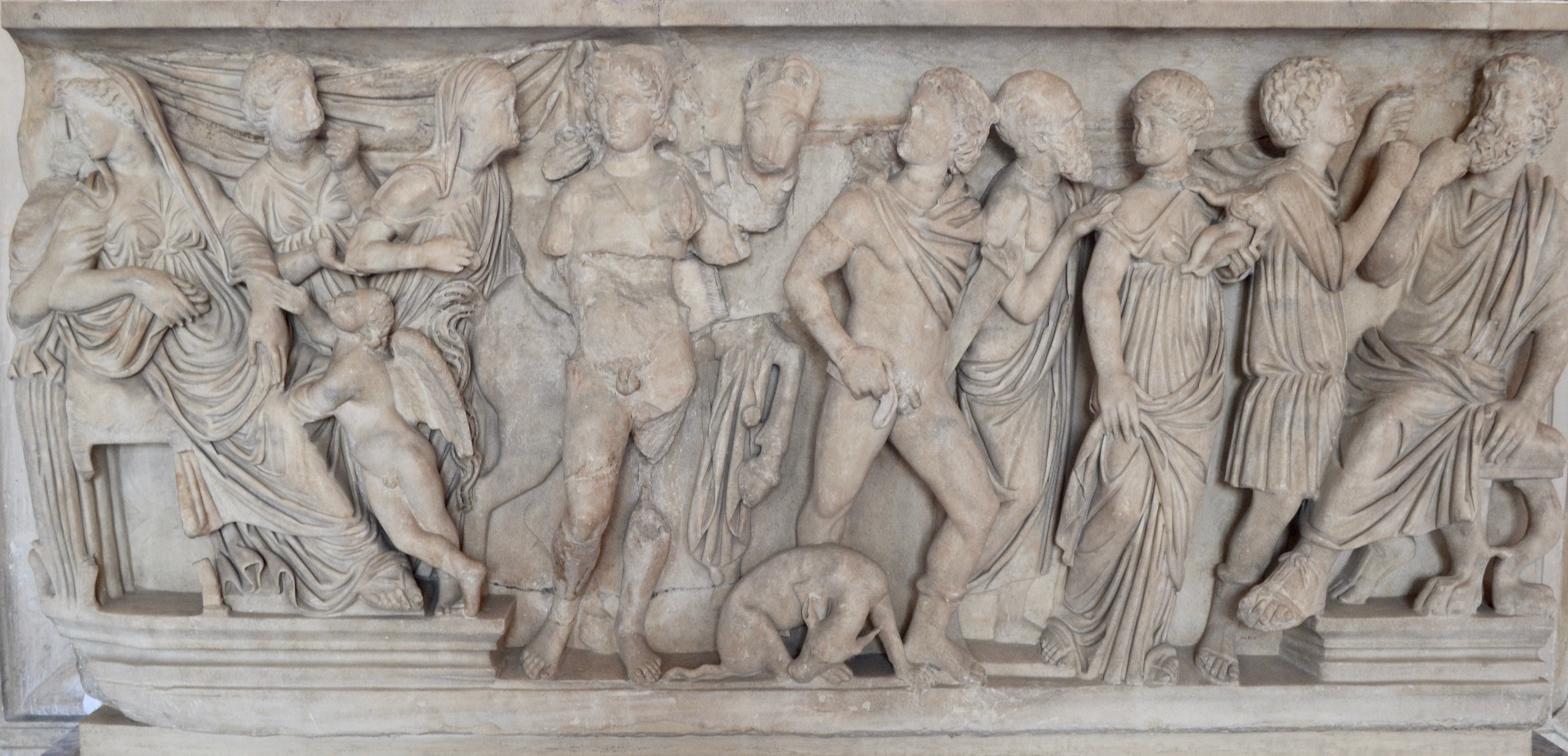
ΑΡΤΕΜΙΣ: ὦ τλῆμον, οἵᾳ συμφορᾷ συνεζύγης· τὸ δ᾿ εὐγενές σε τῶν φρενῶν ἀπώλεσεν.
ΙΠΠΟΛΥΤΟΣ: ἔα· ὦ θεῖον ὀσμῆς πνεῦμα· καὶ γὰρ ἐν κακοῖς ὢν ᾐσθόμην σου κἀνεκουφίσθην δέμας· ἔστ᾿ ἐν τόποισι τοισίδ᾿ Ἄρτεμις θεά.
ΑΡΤΕΜΙΣ: ὦ τλῆμον, ἔστι, σοί γε φιλτάτη θεῶν.
ΙΠΠΟΛΥΤΟΣ: ὁρᾷς με, δέσποιν᾿, ὡς ἔχω, τὸν ἄθλιον;
ΑΡΤΕΜΙΣ: ὁρῶ· κατ᾿ ὄσσων δ᾿ οὐ θέμις βαλεῖν δάκρυ.
ΙΠΠΟΛΥΤΟΣ: οὐκ ἔστι σοι κυναγὸς οὐδ᾿ ὑπηρέτης.
ΑΡΤΕΜΙΣ: οὐ δῆτ᾿· ἀτάρ μοι προσφιλής γ᾿ ἀπόλλυσαι.
ΙΠΠΟΛΥΤΟΣ: οὐδ᾿ ἱππονώμας οὐδ᾿ ἀγαλμάτων φύλαξ.
ΑΡΤΕΜΙΣ: Κύπρις γὰρ ἡ πανοῦργος ὧδ᾿ ἐμήσατο.
ΙΠΠΟΛΥΤΟΣ: ὤμοι, φρονῶ δὴ δαίμον᾿ ἥ μ᾿ ἀπώλεσεν.
ΑΡΤΕΜΙΣ: τιμῆς ἐμέμφθη, σωφρονοῦντι δ᾿ ἤχθετο.
ΙΠΠΟΛΥΤΟΣ: τρεῖς ὄντας ἡμᾶς ὤλεσ᾿, ᾔσθημαι, μία.
ΑΡΤΕΜΙΣ: πατέρα γε καὶ σὲ καὶ τρίτην ξυνάορον (Eur. Hipp. 1389-1404)
Artemis: O poor man, to what a calamity you are yoked! Yet it was the nobility of
your mind that destroyed you.
Hippolytus: But what is this? O breath of divine fragrance! Though I am in misfortune
feel your presence and my body’s pain is lightened. The
goddess Artemis is in this place!
Artemis: Poor one, she is, dearest of gods to you.
Hippolytus: Do you see me, lady, see my wretched state?
Artemis: Yes, but the law forbids my shedding tears.
Hippolytus: No more do you have your huntsman and your servant!
Artemis: No, but though you die, I love you still.
Hippolytus: No one to tend your horses or your statue!
Artemis: No, for unscrupulous Cypris willed it so.
Hippolytus: Ah, now I learn the power that has destroyed me!
Artemis: The slight to her honor angered her, and she hated your chastity.
Hippolytus: One power destroyed us three, I see it now.
Artemis: Your father, you, and Theseus’ wife the third (modified Loeb trans.).
Artemis had also healing powers. As Artemis Podagra she cured gout, as Artemis Chelytis coughing (Clem. Alex. Protrepticus 2, pp. 32, 33 quoting Sosibius), as Artemis Rhokkaia rabies (Ael. NA 14.20) and as Artemis Kokkōka menstruation cramps and labor pangs (incomprehensible to poor Pausanias 5.15.7-8). As Artemis Thermia she presided over healthful hot springs (CIG 6172) and as Artemis Sōteira and Artemis Locheia she helped women in childbirth (Paus. 3.22.12).
She sought to protect virgins in her fold from men pursuing them, but also animals. According to some versions of this famous myth, Artemis transformed the hunter Actaeon into a stag to be torn to pieces by his own hunting dogs after he killed a deer. The more popular version, though, is the one in which Artemis punished him after he had come upon the goddess bathing naked in a stream with her companion nymphs (Ovid. Met. 3.138ff.). Euripides in Bacchae uses a version in which she kills him for having boasted that he surpassed her as a hunter (339-340). A children’s cartoon on American TV a couple of years ago featured a version in which Artemis transformed the hunter Actaeon into a stag to teach him a lesson about not killing animals. The terrified deer (Actaeon) attempted to speak but was unable to make himself understood without a human language. As his fellow hunters are poised to throw their spears and shoot their arrows and the hunting dogs are about to pounce upon the deer Actaeon, he promises Artemis that, if she would only change him back into human form, he would never harm another living being and that he would educate his fellow hunters about the plight and suffering of hunted animals, which was indeed the happy outcome.
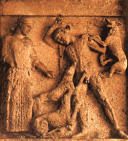
We could end on this cheerful note, but Artemis was a complex goddess. Human sacrifice was also associated with her, especially at Taurus, of all foreign males.
τὰ τῆς θεοῦ δὲ μέμφομαι σοφίσματα,
ἥτις βροτῶν μὲν ἤν τις ἅψηται φόνου,
ἢ καὶ λοχείας ἢ νεκροῦ θίγῃ χεροῖν,
βωμῶν ἀπείργει, μυσαρὸν ὡς ἡγουμένη,
αὐτὴ δὲ θυσίαις ἥδεται βροτοκτόνοις (Eur. IT 380-384).
I criticize Artemis’ clever logic if a mortal
is involved in bloodshed or touches a new
mother or a corpse, she shuts him out from
her altar as polluted, but she herself takes
pleasure in human sacrifice (modified Loeb trans.).
But also of women, virgins, to which the famous sacrifice of Iphigenia, to allow the Greeks favorable winds to sail against Troy, attests.
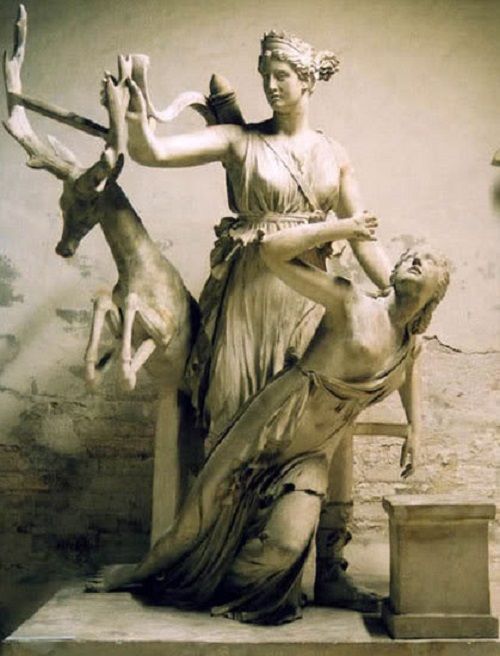
μιαίνων παρθενοσφάγοισιν ῥείθροις
πατρῴους χέρας πέλας βωμοῦ·
τί τῶνδ᾿ ἄνευ κακῶν;
πῶς λιπόναυς γένωμαι
ξυμμαχίας ἁμαρτών;
παυσανέμου γὰρ θυσίας
παρθενίου θ᾿αἵματος ὀργᾷ
περιόργῳ σφ᾿ ἐπιθυμεῖν θέμις.
polluting a father’s hands with streams of a
slaughtered maiden’s blood close by the altar.
Which of these options is free from evil?
How can I become a deserter of the fleet,
losing my alliance? That they should long
with intense passion for a sacrifice to end
the winds and for the blood of a virgin (modified Loeb trans.).
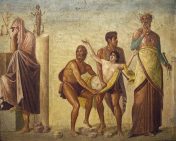
Lucretius’ famous polemic against an unjust religion uses the sacrifice of Iphigenia as an exemplum:
…as when at Aulis, the altar of our Lady of the Crossroads
was foully defiled by the blood of Iphianassa [Iphigenia], shed by chosen
leaders of the Danai, best of men. As soon as the ribbon had
bound her virgin hair falling in equal lengths down either
cheek, as soon as she saw her father standing sorrowful
before the altar, and by his side attendants hiding the knife,
and the people shedding tears at the sight of her, mute with
fear, she sank to the ground on her knees. Poor girl! It did not
help her at such a time that the name of father had been given
the king first by her; for lifted up by the hands of men, all
trembling she was brought to the altar, so that she not in
solemn and sacred ritual might be escorted by loud
wedding song, but a pure virgin to fall by impure hands
at the age of marriage; a victim sorrowful killed by a father’s
hand; all in order that a fair and fortunate release might
be given to the fleet. So powerful was Religion in persuading
evil deeds (Lucretius. De rerum natura 1.83-101, Loeb trans.).
Feminists can claim Artemis as theirs because of her eternal virginity and refusal to marry and have children, and instead choose the company of women, nymphs, and animals. Sexists may also have a case since Artemis could turn against women who defied her by either voluntarily (e.g., Melanippe) or involuntarily (e.g., Callisto, Polyphonte) lose their virginity. Animal rights advocates can also claim her as a protector of animals and all of nature, but those who take pleasure in killing animals, hunters, can also claim her as theirs. Those who celebrate life can claim her as a protector of children, human and non-human, also her association with Eileithyia, the goddess of childbirth, in spite of her own virginity, but so can those who relish in death and destruction since she also demanded human sacrifice and ruthlessly killed all seven of Niobe’s daughters (notwithstanding variations on “all” and the number). Witches can claim her as their high priestess. Many of her festivals were at night under torch-light and the full moon (also her associations with Selene and Hecate) and many healing herbs were under her purview. Witch-hunters can also claim her for the same reasons, honoring Tatian’s famous aspersion against her as a poisoner and Torquemada’s claim that she was the Devil. However, she was also a goddess of light who spent her days bathing in springs and hiking in the mountains; and, of course, she was a goddess of nature (the countryside) but also of culture (the city) — these seemingly contradictory attributes all at the same time. It has been pointed out that the dualism of our modern western Judaeo-Christian thinking was unknown to the ancient Greeks for whom life and death, light and darkness, were simply inextricably connected aspects of the same thing (there is no death without life and vice versa).
Artemis was a complicated, confusing, and contradictory goddess already in antiquity as many regions claimed her as theirs and assigned her various powers to suit their needs, which also varied throughout the centuries. More than most deities in the Greek pantheon, Artemis has suffered from distortions, confusions, appropriations, misrepresentations, and misinterpretations, beginning already in antiquity and it’s been downhill from there (we as classical scholars are not exempt:-).
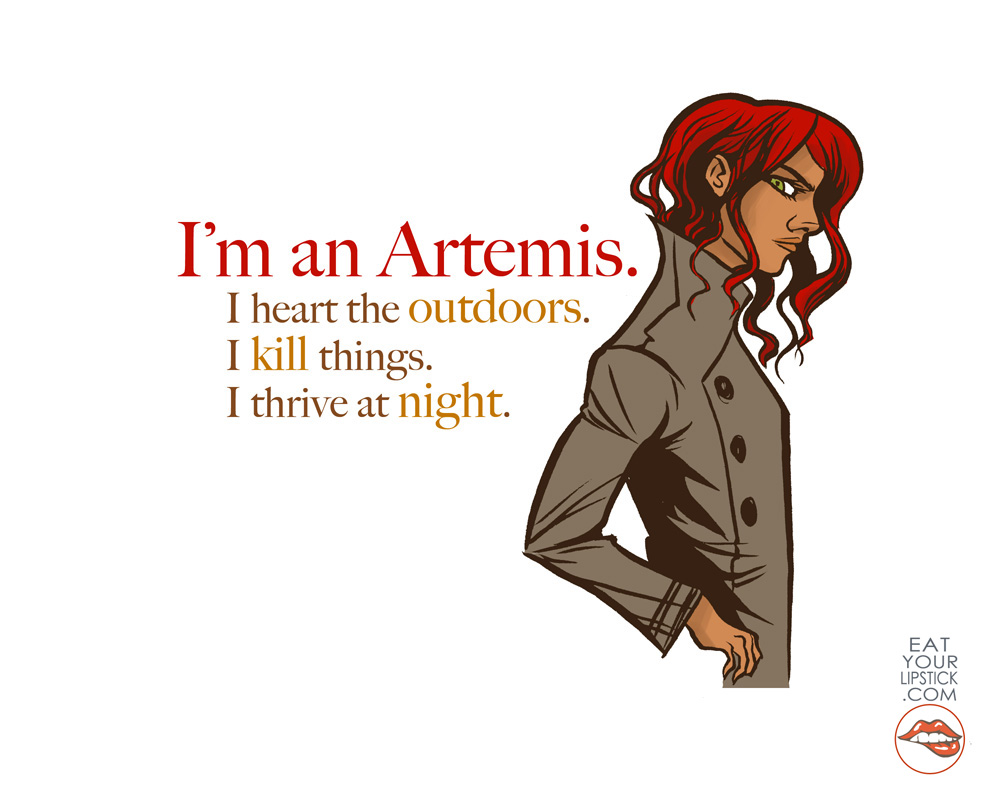
Brief recent book bibliography (currently on display in the Classics Library’s Reading Room):
Budin, S.L. 2016. Artemis. New York.
Ellinger, P. 2009. Artémis, déesse de tous dangers. Paris.
Galiano, P., & Vigna, M. 2015. Diana e Apollo: La selva e l’urbe. Rome.
Janda, M. 2016. Artemis mit der goldenen Spindel. Innsbruck.
Léger, R.M. 2017. Artemis and her Cult. Oxford.
Rogers, G. M. 2012. The Mysteries of Artemis of Ephesos. New Haven.
Vincenti, M.C. 2010. Diana: Storia, mito e culto della grande dea di Aricia. Rome.
Critical editions to Callimachus (Hymn 3 to Artemis) and the Homeric Hymns (27 to Artemis and 6 to Aphrodite):
D’Alessio, G.B. 2007. Callimaco. 4th ed. Milan (BUR).
Asper, M. 2004. Kallimachos von Kyrene: Werke, griechisch-deutsch. Darmstadt.
Pfeiffer, R. 1953. Callimachus, vol. ii: Hymni et epigrammata. Oxford (OCT).
Allen, T.W. 1912. Homeri opera, vol. 5. Oxford (OCT).
Baumeister, A. 1894. Hymni Homerici. Leipzig (Teubner).
Càssola, F. 1975. Inni Omerici. Milan (Mondadori).
Crudden, M. 2001. The Homeric Hymns. Oxford.
Humbert, J. 1936. Homère, hymnes. 2nd ed. Paris (Budé).
[1] Hom. Il. 16.181; Hom. Hymn 5 to Artemis 27; Hom. Hymn 3 to Apollo 190; Hom. Hymn 5 to Aphrodite 115; Apoll. Rhodius Argon. 1.1225; and Ael. NA 12.9.
It’s April at the University of Cincinnati, the end of another eventful academic year. This April was especially busy for UC Libraries, beginning with our 16th annual International Edible Books Festival event on April 3rd. Later in the month, the library hosted my Dean’s Advisory Council, and the board of downtown Cincinnati’s Lloyd Library. We honored Marian A. Spencer, this year’s recipient of the Taft Medal of Notable Achievement at UC’s Distinguished Alumni Celebration, and held our first German-Americana lecture. We celebrated the kickoff of UC’s bicentennial, participated in UC’s Research + Innovation Week and brought music to the Gorno Library.
This is just a short list, in no way comprehensive. It says nothing of UC Libraries’ hardworking faculty, staff and student workers, spread out over 10 campus locations.
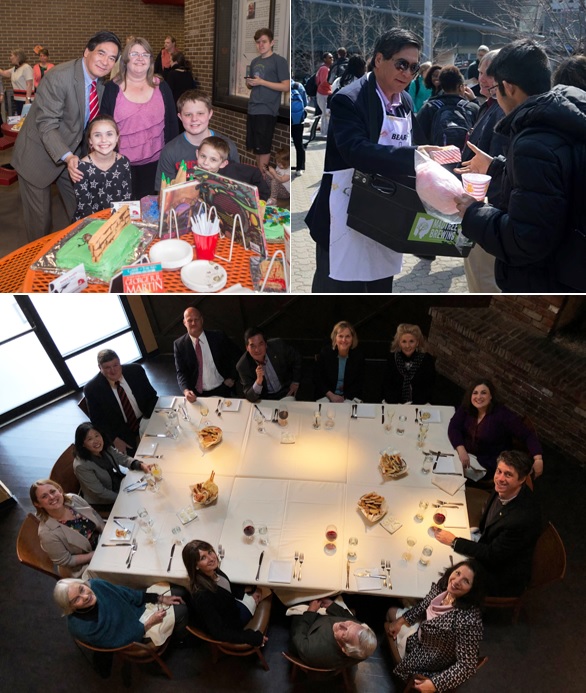
From the upper left hand corner: Celebrating Edible Books; handing out snacks and giveaways at UC’s Bearcat Block Party; dining with members of my Dean’s Advisory Council Continue reading

As heavy snow falls on April 16, it seems appropriate to remind ourselves of the Roman festival, Floralia, in honor of the goddess Flora to usher in spring and flowers and the renewal of all living things (the Greek nymph goddess Chloris had a similar association).
I who now am called Flora was formerly Chloris: a Greek letter of my name is corrupted in the Latin speech. Chloris I was, a nymph of the happy fields where, as you have heard, dwelt fortunate men of old. Modesty shrinks from describing my figure; but it procured the hand of a god for my mother’s daughter. ’Twas spring, and I was roaming… I enjoy perpetual spring; most buxom is the year ever; ever the tree is clothed with leaves, the ground with pasture (Ovid, Fasti, book 5, lines 195-201; 207-208; Loeb transl.).
Chloris eram, quae Flora vocor: corrupta Latinonominis est nostri littera Graeca sono. Chloris eram, nymphe campi felicis, ubi audisrem fortunatis ante fuisse viris.quae fuerit mihi forma, grave est narrare modestae sed generum matri repperit illa deum…vere fruor semper: semper nitidissimus annus, arbor habet frondes, pabula semper humus.
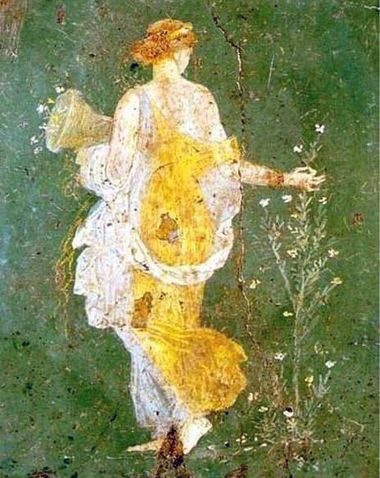
“Flora,” detail of fresco, Villa di Arianna, Stabiae. First century CE.
Some people think that butterflies are the most reliable sign of spring, on account of the extremely delicate structure of that insect; but in the very year in which I am writing this treatise it has been noticed that their supply has been three times annihilated by a return of cold weather, and that migratory birds arriving on January 27 brought a hope of spring that was soon dashed to the ground by a spell of very severe winter. The procedure is two-fold: first of all it consists in trying to obtain a general principle from celestial phenomena, and then this principle has to be investigated by special signs (Pliny the Elder, Natural History, book 18, chapter 57; Loeb transl.).
…sunt qui certissimum veris indicium arbitrentur, ob infirmitatem animalis, papiliones; sed eo ipso anno cum commentaremur haec notatum est proventum eorum ter repetito frigore extinctum, advenasque volucres a. d. vi kal. Febr. spem veris adtulisse mox saevissima hieme conflictatam. res anceps: primum omnium a caelo peti legem, deinde eam argumentis esse quaerendam. super omnia est mundi convexitatis terrarumque globi differentia, eodem sidere alio tempore aliis aperiente se gentibus, quo fit ut causa eius non isdem diebus ubique valeat. addidere difficultatem et auctores diversis in locis observando, mox etiam in isdem diversa prodendo.

The first flower to herald the approach of spring is the white violet, which moreover in the warmer spots peeps out even in winter. Afterwards comes the violet which is called ion, and the mauve one, followed closely by the flame-colored flower called phlox, but only the wild variety. The cyclamen blossoms twice in the year, in spring and in autumn; it shuns summer and winter. A little later than those mentioned above come, overseas, the narcissus and the lily, which in Italy, as we have said, is after the rose. But in Greece comes later still the anemone. This however is a flower of the wild bulbs, and different from the plant to be spoken of among the medicinal herbs. It is followed by the oenanthe, the melanium and the wild heliochrysus, then the other kind of anemone, which is called the meadow anemone, after which comes the gladiolus, together with the hyacinth (Pliny the Elder, Natural History, book 21, chapter 38; Loeb transl.).
Florum prima ver nuntiantium viola alba—tepidioribus vero locis etiam hieme emicat—post ea quae ion appellatur et purpurea, proxime flammeum, quod phlox vocatur, silvestre dumtaxat. cyclaminum bis anno, vere et autumno. aestates hiemesque fugit. seriores supra dictis aliquanto narcissus et lilium trans maria, in Italia quidem, ut diximus, post rosam. verum in Graecia tardius etiamnum anemone. est autem haec silvestrium bulborum flos, alia quam quae dicetur in medicis. sequitur oenanthe ac melanium et ex silvestribus heliochrysos, deinde alterum genus anemones quae limonia vocatur, post hanc gladiolus comitatus.

The Classics Library’s “Book of the Month” in April: Wild Flowers of Cyprus.
See the delightful Facebook post about this book by PhD candidate Angelica Wisenbarger:
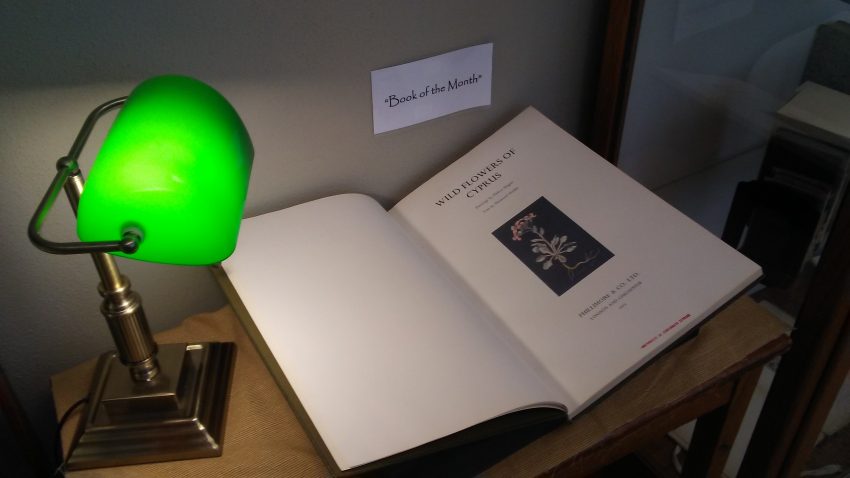
…the blossom is the token of full spring and of the rebirth of the year—the blossom is the trees’ rejoicing: it is then that they show themselves new creatures and transformed from what they really are, it is then that they quite revel in rivaling each other with the varied hues of their coloring (Pliny the Elder, Natural History, book 16, chapter 40; Loeb transl.).
…flos est pleni veris indicium et anni renascentis, flos gaudium arborum: tunc se novas aliasque quam sunt ostendunt, tunc variis colorum picturis in certamen usque luxuriant.
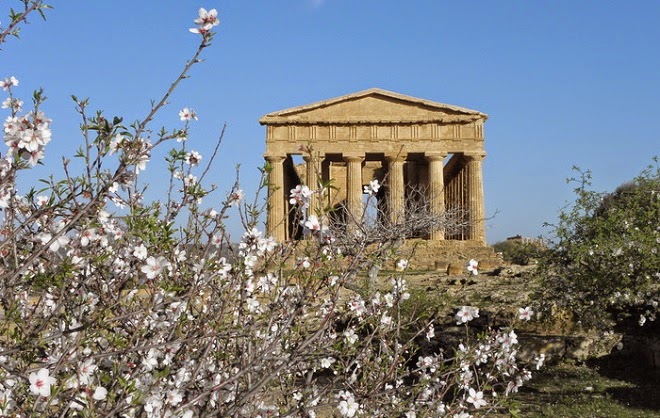
Almond trees in bloom at Agrigentum (Agrigento), Sicily.

“Spring” from The Four Seasons by Antonio Vivaldi.
https://www.youtube.com/watch?v=mFWQgxXM_b8
I Vespri Siciliani, Act 3, “Spring” by Giuseppe Verdi.
https://www.youtube.com/watch?v=RMiKEOI4Y3g

Colorful rendition of Flora, from Sandro Botticelli’s Primavera.
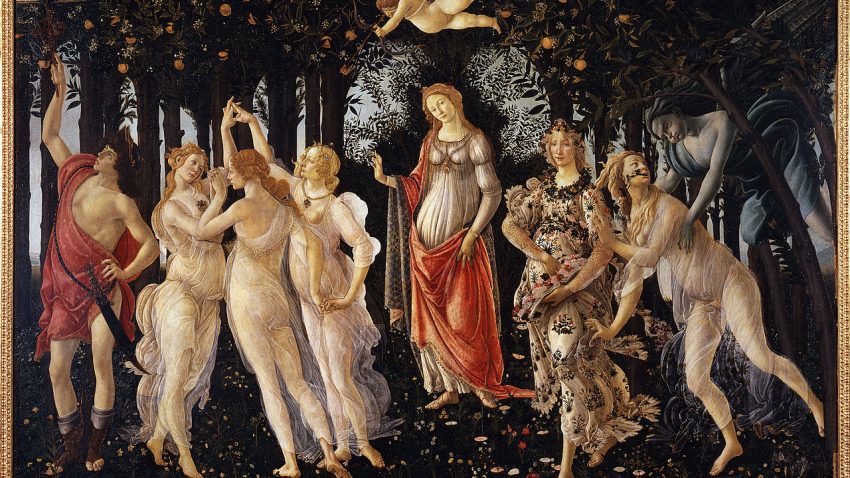
The real thing. The Uffizi Gallery, Florence, Italy.

The University of Cincinnati Libraries and IT@UC Research & Development announce the next in the Data & Computational Science Series (DCS2) 2018, a speaker series supported by a Universal Provider award from UC’s Office of the Provost for faculty development.
DCS2 brings to the University of Cincinnati research community a variety of innovative workshops and distinguished speakers on advanced research data topics including high performance computing, cloud computing, data visualization, research story-mapping, spatial analysis, artificial intelligence and machine learning. The workshops are free and open to all, but registration is required. Continue reading
With the end of the semester comes change. And this is also true for the Data & GIS Collab. Our wonderful student Shiyu Gong will end her time with us as finals end this week. We thank her for all the hard work and wish her the best as she pursues the goals of her next phase of education. You will do amazing work!
We also welcome a new student to the lab. Zhiyuan Yao will join us starting April 30th. She is a Geography & GIS graduate student and has much GIS expertise. She has been a TA for both introduction and intermediate GIS courses and is interested in transportation research. She is eager to help you with your spatial analysis. Come visit her in the Collab. Hours for the lab are posted at https://guides.libraries.uc.edu/GISandData/Collab

Richard poses in front of the Visualization Wall.
On Monday, April 23, Richard Johansen started work in the Geology-Mathematics-Physics Library as Data Visualization Specialist.
Richard is already a fellow UC Bearcat, previously serving as a Research Assistant in the College of Arts and Sciences’ Department of Geography and GIS. He has worked on a host of interdisciplinary projects, and has a wealth of experience in spatial and data analyses using a variety of analytical and visualization software. Richard is currently a PhD candidate in UC’s Geography and GIS Department, and holds a BS in geosciences and a MA in geography and planning. Outside of work, he is an avid traveler, bizarre food lover and self-described space nerd.
As the Data Visualization Specialist, Richard joins the Science and Engineering Libraries unit and the Researcher Services team. He will develop a distinctive program of support in data visualization that will enable innovations in teaching and research. As part of this work, he will manage the new Visualization Laboratory located in the Geology-Mathematics-Physics Library, including its operations and technology. More broadly, he will be a resource and consultant for faculty and scholars on visual thinking and data visualization techniques and software.
Welcome, Richard, to UC Libraries!
The UC Classics Library celebrated the birthday and 2000-year anniversary of the ancient Roman poet Publius Ouidius Naso (20 March 43 BCE – CE 17/18) on March 29, 2018. See UC President Pinto’s tweet: https://twitter.com/UCLibraries/status/978291186975805440
Thank you to all the outstanding participants and to all those who attended!
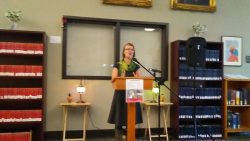
Dr. Bridget Langley, UC Classics Department, gave a brilliant and hysterically funny talk on Ovid.

Dr. Colin Shelton, UC Classics Department, read the tale of Echo and Narcissus, in a hauntingly beautiful and suggestive manner, in Latin and in translation/interpretation by modern English poet Ted Hughes. It gave us all goose bumps.
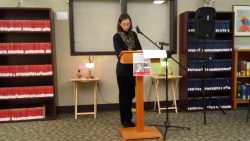
Dr. Jenny Doctor, Library, UC College-Conservatory of Music, gave a fascinating talk on modern English composer Benjamin Britten and his opus 49 for solo oboe, “Six Metamorphoses after Ovid,” as well as introduced the piece’s individual metamorphoses and the oboist.
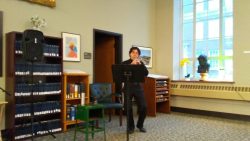
Yo Shionoya, oboist, UC College-Conservatory of Music. If we were not already Britten and oboe fans, we all became such after his outstanding performance. Yo is an amazing musician, who although a graduate student, has a full program of public appearances. He, not Ovid, dictated the date of the event. Many of us were moved to tears (of joy) during his rendition of the heart-wrenching grief of Niobe, the loving “self-reflection” of Narcissus, the hubris of the flight of Phaeton.
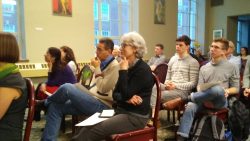
It was a full house!
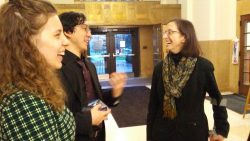
Yo Shionoya and Jenny Doctor enjoying themselves at the reception.
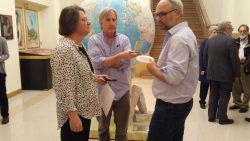
Professors Susan Prince, Jack Davis, Steven Ellis, UC Classics Department, in deep conversation.
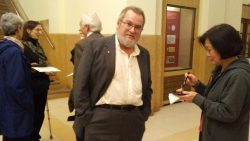
Mike Braunlin, UC Classics Library, Bibliographer and Numismatist, handsome in a rare suit.
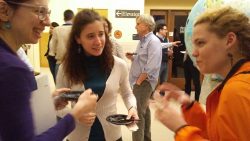
Three of the UC Classics Department’s bright students, Maria Gaki, Cecilia Cozzi, Kelly Grogan.
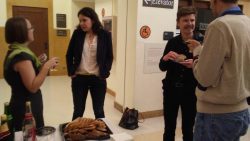
“Performers” Bridget Langley and Colin Shelton relaxing together with Professor Valeria Sergueenkova and Tytus Fellow Salvador Bartera.
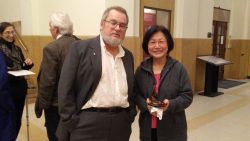
Mike Braunlin, UC Classics Library, and May Chang, UC Libraries’ Chief Technology Officer. May, although a techie, borrowed a book of Ovid’s Metamorphoses after the event and commented that if she had had Bridget and Colin as teachers of Latin, she may have chosen Classics instead of IT, which highlights the importance of Latin teachers that enthuse rather than frustrate their students.
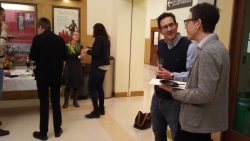
UC Classics Professors Antonios Kotsonas and Daniel Markovich in spirited conversation.
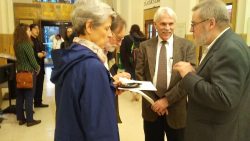
Dan Gottlieb, UC Libraries, Senior Adviser to the Dean and Interim Dean of Library Services, Humanities, and Social Sciences, and Mike Braunlin having fun.

The delicious and healthy and “ancient Roman” refreshments prepared by Christina Miller, vegan chef at Whole Foods — roasted asparagus, wild mushrooms, leeks, dates, cinnamon apples, figs, melon, strawberries, grapes, breads, olives, nuts. Ovid would have enjoyed this feast, free from animal suffering, hormones, and pesticides and perfectly in line with UC President Pinto’s new strategic directions, Next Lives Here! It is our hope that human health, the health of the environment, and kindness to all sentient beings become the norm for receptions at UC. Ovid himself said it best: “The earth, prodigal of her wealth, provides you with her sweet sustenance and offers you food without bloodshed and slaughter” (Metamorphoses book 15, lines 81-83).

The attendees were also treated to “ancient Roman” candy, the so called Confetti di Sulmona, from Ovid’s hometown of ancient Sulmo, present-day Sulmona, in the province of Abruzzo, Italy.

Although born in Sulmo, exiled to Tomis by the Black Sea, present-day Constanța, Romania, where he died, it was the City of Rome Ovid called home. The She-Wolf with the legendary twin founders of Rome, Romulus and Remus, has become a symbol of Rome, also here in Cincinnati (Eden Park).
If you wish to read Ovid’s Metamorphoses or any other work from his quite extensive œuvre, you could, for example, use the translations with parallel Latin texts in the Loeb Classical Library series. Here are the perhaps best known of Ovid’s poems:
Metamorphoses — https://www.loebclassics.com/view/ovid-metamorphoses/1916/pb_LCL042.3.xml?rskey=7TOGFu&result=1
Fasti — https://www.loebclassics.com/view/ovid-fasti/1931/pb_LCL253.3.xml?rskey=0FvawT&result=13
Amores — https://www.loebclassics.com/view/ovid-amores/1914/pb_LCL041.319.xml?rskey=lwyxTu&result=10
Ars Amatoria — https://www.loebclassics.com/view/ovid-art_love/1929/pb_LCL232.13.xml?rskey=lwyxTu&result=7
Tristia — https://www.loebclassics.com/view/ovid-tristia/1924/pb_LCL151.3.xml?rskey=lwyxTu&result=5
(Epistulae) Ex Ponto — https://www.loebclassics.com/view/ovid-ex_ponto/1924/pb_LCL151.265.xml?rskey=lwyxTu&result=8
Dr. Shelton read from the Latin text of the Metamorphoses from the so called Oxford Classical Text edition:
Tarrant, R.J. 2004. P. Ovidi Nasonis Metamorphoses: Recognovit brevique adnotatione critica instruxit. Oxford University Press.
And from the English translation by Ted Hughes:
Hughes, Ted. 1997. Tales from Ovid. Faber & Faber. Also online from Chadwyck-Healey (ProQuest): https://literature.proquest.com/toc.do?sourceId=Z000561710&action=new&area=poetry-toc&divLevel=0&queryId=&mapping=toc#scroll&DurUrl=Yes
Another very readable and accessible translation is that of Charles Martin, with introduction by Bernard Knox.
Martin, C. 2010. Metamorphoses : A new translation, contexts, criticism. Norton.
Moreover, be sure to check out graduate student Angelica Wisenbarger’s amusing and witty description of March’s “Book of the Month,” an Elzevir edition of the Metamorphoses from 1629: https://www.facebook.com/notes/uc-libraries/carmina-mutata-in-nova-corpora-classics-book-of-the-month-march-2018-ovids-metam/1882836821750116/
You could also check out the video of the Ovid celebration; however, the sound quality is poor. https://www.youtube.com/watch?v=NI67mschhQM&feature=em-share_video_user
Finally, don’t miss the book exhibits, still up in the Classics Library’s Reading Room, of rare editions of the works of Ovid with Emperor Augustus, the source of much of Ovid’s chagrin, on top of the display, from a UC excavation at Troy.

 Summer semester the Clermont College Library is pleased to exhibit the art of Molly Newton, Lily Barnes, and Amanda Wittmer. Molly and Lily have created works in pencil and pen, while Amanda used oil pastel, acrylic, and collage.
Summer semester the Clermont College Library is pleased to exhibit the art of Molly Newton, Lily Barnes, and Amanda Wittmer. Molly and Lily have created works in pencil and pen, while Amanda used oil pastel, acrylic, and collage.
A recent trip to Thailand influenced Amanda’s work. Her piece, Missing Home, received the Editor’s Choice Award in the East Fork Journal. In the fall, she will pursue a graduate degree in Art Therapy at Adler University in Chicago.
Come check out the student art in the library’s Student Art Spotlight throughout the summer, 2018. As always, we thank Fine Arts faculty Kelly Frigard and Kim Taylor for their dedicated support of the Student Art Spotlight since 2015.
Penny McGinnis
Technical Services Manager
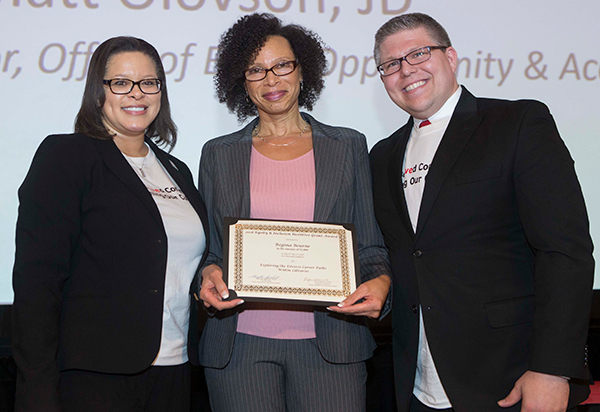
Regina Bourne (center), Library Human Resources and Organizational Development Director, is presented with the grant award. UC/ Joseph Fuqua II
The University of Cincinnati Libraries were awarded an Equity & Inclusion Incentive Grant for the proposal “Exploring the Diverse Career Paths within Libraries,” which aims to introduce and educate minority high school students to the academic library profession for the purpose of attracting them into the profession.
Submitted by UC Libraries, in collaboration with Cincinnati Public Schools, University of Cincinnati Admissions, and partners within the library, the grant will support the creation of two half-day programs for up to 60 college-bound high school minority students from local area schools. Throughout the course of the day, the students will: take a tour of the library; meet faculty and staff with a range of skills and educational backgrounds; engage in learning activities related to library professions; learn about the experiences of student workers currently employed by the library; and gain an understanding of the multitude of career options the library has to offer.
This outreach initiative will address the current trend of retiring librarians, introduce students to diverse disciplines and cultivate interest in the library profession among the visiting students. It will also show how IT skills can be used in the library profession and educate the student visitors about library student worker jobs. Student visitors will be given flash drives uploaded with additional information about libraries to continue to engage them after the day is over.
UC Libraries’ faculty, staff and student workers who help to facilitate the program will gain valuable experience and professional development in diversity and inclusion.
The university’s Equity & Inclusion Incentive Grant program seeks to support collaborative efforts between colleges and units to enhance diversity and inclusion through innovative practices that align with the goals and objectives in the Diversity Plan.